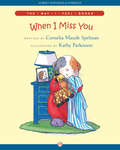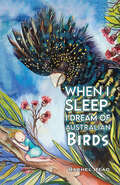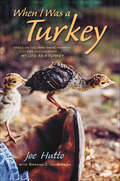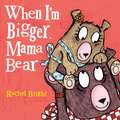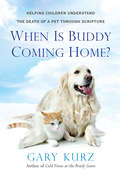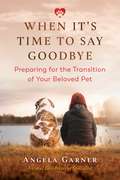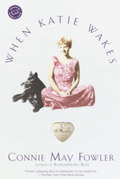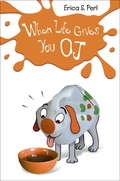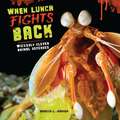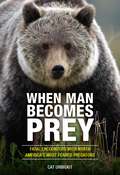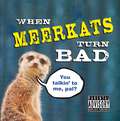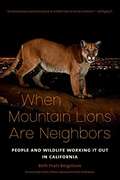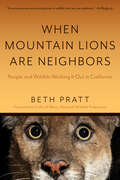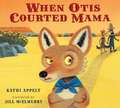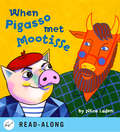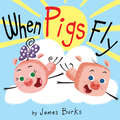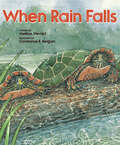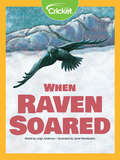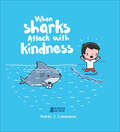- Table View
- List View
When I Met the Wolf Girls
by Deborah NoyesTwo little girls-raised by wolves-have just arrived at the orphanage, and life will never be the same. Based on a true story, this book is about many things at once: family, friendship, and what it means to have a home.
When I Miss You
by Kathy Parkinson Cornelia Maude SpelmanYoung children often experience anxiety when they are separated from their mothers or fathers. This newest title in The Way I Feel series features a young guinea pig who expresses her distress when her mother and father go away. "Missing you is a heavy, achy feeling. I don't like missing you. I want you right now!" Eventually the little guinea pig realizes that sometimes she and her parents can't be together. When that happens, she knows that others can help. "They can snuggle with me or we can play. It helps me to be warm and close to someone. They remind me that you'll be back." This is a fixed-format ebook, which preserves the design and layout of the original print book.
When I Sleep, I Dream of Australian Birds
by Rachel HeadWhat do we dream of when we sleep, what journeys do we take? Do we dream of faraway lands, beautiful creatures? Go on an adventure around Australia and discover the beautiful colourful birds of a variety of regions. This book is designed to grow with your child, offering not only an imaginative story but also educational information about the fascinating birds featured within its pages. As your little one develops, you can explore the factual tidbits together, nurturing their curiosity and love for the natural world.
When I Was a Turkey: Based on the Emmy Award-Winning PBS Documentary My Life as a Turkey
by Brenda Z. Guiberson Joe HuttoWhen I Was a Turkey is a middle-grade adaptation of the remarkable true story of a naturalist who raised a flock of wild turkeys using imprinting.After a local farmer left a bowl of wild turkey eggs on Joe Hutto’s front porch, his life was forever changed. Hutto incubated the eggs and waited for them to hatch. Deep in the wilds of Florida’s Flatlands, Hutto spent each day living as a turkey mother, taking on the full-time job of raising sixteen turkey chicks. For two years, Hutto dutifully cared for his family, roosting with them, taking them foraging, and immersing himself in their world. In return, they taught him how to see the world through their eyes. Here is the remarkable true story of a man with a singular gift to connect with nature. A Christy Ottaviano Book
When I'm Bigger, Mama Bear (Mama and Bella Bear)
by Rachel BrightFrom Rachel Bright, the bestselling author and illustrator of Love Monster, comes a warm and relatable parent-child story about learning to love exactly who you are right now in When I'm Bigger, Mama Bear.The beloved mother-daughter bear pair from In a Minute, Mama Bear are back, making lunch and running errands. But Bella Bear wants to do BIG bear things, like bike to the store alone and chop up vegetables. Mama Bear tries to tell her she's too little to do these things by herself, but Bella doesn't want to listen. Luckily, when Bella climbs too high and needs help, Mama is right there to lend a helping hand.
When Is Buddy Coming Home?: A Parent's Guide to Helping Your Child with the Loss of a Pet
by Gary KurzMommy, will I ever see Buddy again?How do we explain to our little ones that their beloved pets have gone home to be with the Lord? Do our loyal animal companions understand how deeply they are missed? For children, the sudden loss of a precious pet can inspire difficult questions about life and death. How can we reassure mourning youngsters that our dearly departed pets have found everlasting peace? Gary Kurz, acclaimed author of Cold Noses at the Pearly Gates and Wagging Tails in Heaven, provides thoughtful guidance on soothing a child’s heartbreak after the passing of a beloved four-legged friend—affirming that through their unconditional love, every one of them has a unique place in heaven. Sensitive and insightful, When Is Buddy Coming Home? reveals the power of faith in the wake of grief, uplifting animal lovers of all ages with the comfort that separation from our loved ones—including those with paws, tails, and wings—is only temporary. Praise for Gary Kurz and Cold Noses at the Pearly Gates “Wonderful, inspiring and comforting.” —Mary Buddemeyer-Porter, author of Will I See Fido in Heaven? “A great comfort to me and all I am associated with.” —Terry Hickey, Founder, Halton/Peel Pet Loss Support Group
When It’s Time to Say Goodbye: Preparing for the Transition of Your Beloved Pet
by Angela GarnerPractical guidance and compassionate support for pet owners before, during, and after the death of a beloved companion animal • Explores how best to prepare for the death of your pet, including recognizing changes in your animal&’s well-being, palliative care at home, taking care of your pet&’s remains, ceremonies, and more • Offers practical exercises and activities, such as what to discuss with the vet when euthanasia is anticipated, how to retain a center of inner calm when making decisions, and how to find the courage to say goodbye when the time comes • Addresses the emotional components of the bereavement process--fears beforehand, guilt and anger afterward--and offers advice on self-care throughout Our pets are members of our families. The death or separation from a beloved animal friend--whether anticipated or unexpected--can unleash a roller coaster of emotions. In this compassionate guide based on 20 years' experience helping individuals and teaching veterinary professionals, Angela Garner offers practical support and guidance to help you prepare for your pet&’s death ahead of time, do your best by your animal friend when the time comes, and work through your grieving process afterward. The author explores how best to prepare for the death of your beloved pet, including recognizing changes in your pet&’s well-being, palliative care at home, taking care of your pet&’s remains, ceremonies, and more. She discusses natural death and euthanasia and offers exercises and activities to help you work through difficult issues, such as what to discuss with the vet and how to stay focused on your pet&’s welfare when euthanasia is anticipated. Sharing her own experiences and those of others, she explores practices to help you cope with fears and overwhelming emotions, retain a center of inner calm when making crucial decisions, and find the courage to say goodbye when it is time. Angela Garner also addresses the different emotional components of the bereavement process--fears beforehand and guilt and anger afterward--and includes a compassionate discussion about children and pet loss as well as how to support a grieving companion animal in the family. Offering step-by-step support throughout, this guide brings hope and reassurance that, while grief may feel insurmountable, you will come out the other side to once again reengage with life.
When Katie Wakes
by Connie May FowlerBestselling author Connie May Fowler tells her own extraordinary story for the first time-the harrowing years of her childhood followed by the abusive relationship she endured as a young woman-and how the unconditional love of her dog helped her escape her physical and emotional bonds.Before Women Had Wings, Connie May Fowler's award-winning and bestselling fictional account of domestic abuse, touched thousands. In this piercing memoir, Fowler chronicles the emotional battery and physical abuse that marked her own passage to adulthood. She draws a searing portrait of growing up with her manipulative and needy mother, a woman unable to give the love and comfort every child has a right to expect. And then, as a young woman, Fowler found herself involved with a man whose behavior disturbingly echoed her mother's. The man she lived with alternately displayed a desperate need for her or rejected her as if she were worse than useless. With heart-wrenching candor, Fowler records the abuse she suffered at his hands, from his constant attempts to undermine her self- confidence to his acts of brutal physical violence. The unconditional love Fowler longed for finally came-in the shape of an adoring Labrador puppy named Kateland. With Katie at her side, she was able to withstand her mistreatment and the crushing weight of her childhood and, miraculously, managed to create a small refuge from the horrors that surrounded her. This is the story of her decision to end the years of mistreatment and even to open her life to a new, gentle man, whose love and understanding helped to transform her. Well known for her fiction and her work with victims of domestic abuse, Fowler now offers a strong helping hand to women everywhere in this startling, revealing, and ultimately inspiring memoir.From the Hardcover edition.
When Life Gives You O.J.
by Erica S. Perl<P>For years, 10-year-old Zelly Fried has tried to convince her parents to let her have a dog. <P>After all, practically everyone in Vermont owns a dog, and it sure could go a long way helping Zelly fit in since moving there from Brooklyn. <P>But when her eccentric grandfather Ace hatches a ridiculous plan involving a "practice dog" named OJ, Zelly's not so sure how far she's willing to go to win a dog of her own. <P>Is Ace's plan so crazy it just might work . . . or is it just plain crazy? <P>Erica S. Perl weaves an affectionate and hilarious tale that captures the enduring bond between grandparents and grandchildren. Even when they're driving each other nuts.
When Love Is Not Enough: A Guide to Parenting Children with RAD-Reactive Attachment Disorder
by Nancy ThomasA clear, focused plan for parenting disturbed children back to health
When Lunch Fights Back: Wickedly Clever Animal Defenses
by Rebecca JohnsonGood defenses can make the difference between surviving a predator's attack and becoming its lunch. See newts that pop their rib bones through their skin; termites that carry poison-filled backpacks; lizards that shoot blood from their eyes, and more!
When Man Becomes Prey: Fatal Encounters with North America's Most Feared Predators
by Cat UrbigkitSam Ives&’s family set up camp in a Utah campground, cooked dinner, cleaned up and packed their gear away, and climbed into their multi-chambered tent to sleep. It was a great end to Father&’s Day. Eleven-year-old Sam crawled into the smaller compartment of the two-room tent. Without his parents knowing it, Sam ate a granola bar and placed the empty wrapper in a pocket of the tent. Sometime during the night, a black bear entered the campsite, ripped open the side of the tent where Sam slept, grabbed the boy, and killed him. His parents heard a noise and got up to have a look around, but were unable to find Sam. Terrified, they immediately called for help and a search was quickly conducted, where Sam&’s body was found about 400 yards from the campsite.Unfortunately, Sam&’s story is not uncommon—every year there are numerous reports of predator attacks on humans, many of them resulting in fatalities. When Man Becomes Prey examines the details of fatal predator attacks on humans, providing an opportunity to learn about the factors and behaviors that led to attacks. The predators profiled in the book include black bears, grizzly bears, mountain lions, coyotes, and gray wolves—the first time all five species have been included in one volume. Compelling narratives of conflicts involving these top predators are accompanied by how-to information for avoiding such clashes.
When Meerkats Turn Bad
by Kitty LitterMeerkats look cute with their little noses in the air. But have you ever paused to wonder what’s really going on in those cosy communities? There’s a darker side to the cuddly meerkat, and the shocking truth is revealed here for the first time in When Meerkats Turn Bad.
When Meerkats Turn Bad
by Kitty LitterMeerkats look cute with their little noses in the air. But have you ever paused to wonder what’s really going on in those cosy communities? There’s a darker side to the cuddly meerkat, and the shocking truth is revealed here for the first time in When Meerkats Turn Bad.
When Mountain Lions Are Neighbors: People and Wildlife Working It Out in California
by Beth Pratt-Bergstrom“This delightful book details our ever-evolving relationship with Earth’s wildest creatures, promising that peaceful coexistence is possible.” —Jennifer Holland, New York Times–bestselling authorWildness beats in the heart of California’s urban areas. In Los Angeles, residents are rallying to build one of the largest wildlife crossings in the world because of the plight of one lonely mountain lion named P-22. Porpoises cavort in San Francisco Bay again because of a grassroots effort to clean up a waterway that was once a toxic mess. And on the Facebook campus in Silicon Valley, Mark Zuckerberg and his staff have provided a home for an endearing family of wild gray foxes. Through actions as sweeping as citizen science initiatives and as instantaneous as social media posts, a movement of diverse individuals and communities is taking action to recast nature as an integral part of our everyday lives. When Mountain Lions Are Neighbors explores this evolving dynamic between humans and animals, including remarkable stories like the journey of the wolf OR-7 and how Californians are welcoming wolves back to the state after a ninety-year absence, how park staff and millions of visitors rallied to keep Yosemite’s famed bears wild, and many more tales from across the state. Written by Beth Pratt-Bergstrom of the National Wildlife Federation, these inspiring stories celebrate a new paradigm for wildlife conservation: coexistence.“A contemporary and exciting view of conservation that we all can celebrate.” —Ed Begley Jr.“When Mountain Lions Are Neighbors focuses on a serious problem by presenting meaningful solutions, and is as enjoyable to read as it is informative.” —Foreword Reviews
When Mountain Lions Are Neighbors: People and Wildlife Working It Out in California (With a New Preface)
by Beth PrattNow updated with a new preface: a full-color celebration of coexistence with California's iconic wildlife.Wildness beats in the heart of California's urban areas, and across the state Californians are taking action to recast wildlife as an integral part of our everyday lives. In Los Angeles, residents rallied to build one of the largest wildlife crossings in the world because of the plight of one lonely mountain lion named P-22. Porpoises cavort in San Francisco Bay again because of a grassroots effort to clean up a waterway that was once a toxic mess. Yosemite's park staff and millions of visitors have mobilized to keep its famed bears wild. And after a near century-long absence, Californians are welcoming wolves back to the state, inspired by the remarkable journey of the wolf OR-7. When Mountain Lions Are Neighbors explores this evolving dynamic between humans and animals. Now updated with a new preface, these inspiring stories celebrate a new model for wildlife conservation: coexistence.
When Mountain Lions are Neighbors: People and Wildlife Working It Out in California
by Beth Pratt-BergstromWildness beats in the heart of California's urban areas. In Los Angeles, residents are rallying to build one of the largest wildlife crossings in the world because of the plight of one lonely mountain lion named P-22. Porpoises cavort in San Francisco Bay again because of a grassroots effort to clean up a waterway that was once a toxic mess. And on the Facebook campus in Silicon Valley, Mark Zuckerberg and his staff have provided a home for an endearing family of wild gray foxes. Through actions as sweeping as citizen science initiatives and as instantaneous as social media posts, a movement of diverse individuals and communities is taking action to recast nature as an integral part of our everyday lives. When Mountain Lions Are Neighbors explores this evolving dynamic between humans and animals, including remarkable stories like the journey of the wolf OR-7 and how Californians are welcoming wolves back to the state after a ninety-year absence, how park staff and millions of visitors rallied to keep Yosemite's famed bears wild, and many more tales from across the state. Written by Beth Pratt-Bergstrom of the National Wildlife Federation, these inspiring stories celebrate a new paradigm for wildlife conservation: coexistence.
When Otis Courted Mama
by Kathi Appelt Cyndy Szekeres Jill McElmurryWhile his life seems perfectly good as it is, Cardell, a young coyote, learns to tolerate--and even like--the coyote that is courting his mother.
When Pigasso Met Mootisse
by Nina LadenWhen Pigasso met Mootisse, what begins as a neighborly overture escalates into a mess. Before you can say paint-by-numbers, the two artists become fierce rivals, calling each other names and ultimately building a fence between them. But when the two painters paint opposite sides of the fence that divides them, they unknowingly create a modern art masterpiece, and learn it is their friendship that is the true work of art.Nina Laden's wacky illustrations complement this funny story that non only introduces children to two of the world's most extraordinary modern artists, but teaches a very important lesson—how to creatively resolve a conflict—in a most unusual way.
When Pigs Fly (Hyperion Picture Book (eBook))
by James BurksHenry is ready to do what no pig has done before. "But pigs can't fly," says his sister, Henrietta. Nothing will stop Henry from trying, until it looks as though gravity might finally get the better of him. Fortunately, Henrietta has an idea that gives both of them a lift. Henry's determination and Henrietta's imagination combine to make a positive sibling story about creative play and teamwork.
When Rain Falls
by Melissa StewartA colorful look at the amazing ways animals behave and interact with their environments on a rainy day.We go inside when the rain comes down, but where do animals go? This engaging book for young readers offers a first glimpse at how different animals in different habitats behave during a thunderstorm. Acclaimed children's nonfiction author Melissa Stewart takes a lyrical look at the behavior of animals in forests, fields, wetlands, and deserts and briefly describes how each creature interacts with its rained-soaked environment. Constance Bergum's soft watercolor paintings colorfully depict the animals and special features of each habitat.
When Raven Soared
by Janet Montecalvo Leigh AndersonIn this story from the Native Americans of the Pacific Northwest, you’ll learn how the trickster raven brings light back to the world from a greedy chief.
When Sharks Attack With Kindness
by Andrés J. ColmenaresThis hardcover collection features the cute, uplifting and ingenious aquatic cartoons of Andrés Colmenares, the creator of Wawawiwa Comics, followed by millions of fans around the globe. While sharks are one of the ocean&’s deadliest predators, these sharks can smell insecurity, doubt, and gloom, and are quick to strike — with kindness, cuteness, and positivity!When Sharks Attack With Kindness includes a QR code linking to a special instrumental soundtrack for audiences to enjoy while reading the book.
When Sharks Attack With Kindness
by Andrés J. ColmenaresThis hardcover collection features the cute, uplifting and ingenious aquatic cartoons of Andrés Colmenares, the creator of Wawawiwa Comics, followed by millions of fans around the globe. While sharks are one of the ocean&’s deadliest predators, these sharks can smell insecurity, doubt, and gloom, and are quick to strike — with kindness, cuteness, and positivity!When Sharks Attack With Kindness includes a QR code linking to a special instrumental soundtrack for audiences to enjoy while reading the book.
When Sharks Attack With Kindness
by Andrés J. ColmenaresThis hardcover collection features the cute, uplifting and ingenious aquatic cartoons of Andrés Colmenares, the creator of Wawawiwa Comics, followed by millions of fans around the globe. While sharks are one of the ocean&’s deadliest predators, these sharks can smell insecurity, doubt, and gloom, and are quick to strike — with kindness, cuteness, and positivity!When Sharks Attack With Kindness includes a QR code linking to a special instrumental soundtrack for audiences to enjoy while reading the book.

